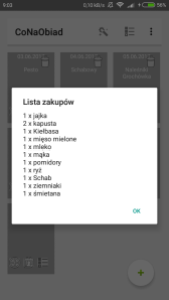Ciągle pracuję nad lepszym GUI i przy okazji poprawiam kod. Znajduję miejsca, które niespecjalnie mi się podobają i przerabiam. Dużo pracy przede mną 😉 Na przykład to: skoro już wysyłam zapytanie do bazy, to przydałoby się na tym jak najwięcej ugrać.
Pierwotnie kod, który tworzył listę zakupów wyglądał tak:
This file contains hidden or bidirectional Unicode text that may be interpreted or compiled differently than what appears below. To review, open the file in an editor that reveals hidden Unicode characters.
Learn more about bidirectional Unicode characters
| private String getShoppingListQuery(List<Meal> meals) { | |
| StringBuffer sb = new StringBuffer(); | |
| sb.append("select name, count(name) from ("); | |
| for (int i = 0; i < meals.size(); i++) { | |
| sb.append(getIngredientsQuery()); | |
| if (i < meals.size() – 1) { | |
| sb.append(" union all "); | |
| } | |
| } | |
| sb.append(") group by name order by name collate nocase;"); | |
| return sb.toString(); | |
| } |
Zwykły select ze zliczaniem ile razy name pojawiło się na liście składników. W podzapytaniu query odpytujące bazę o listę składników do każdego obiadu połączone 'union all’, żeby nie usunęło z wyników powtarzających się składników.
Jak już wypluje te składniki i ich liczbę to trzeba to wrzucić na listę:
This file contains hidden or bidirectional Unicode text that may be interpreted or compiled differently than what appears below. To review, open the file in an editor that reveals hidden Unicode characters.
Learn more about bidirectional Unicode characters
| Cursor res = db.rawQuery(query, queryArgs); | |
| if (res != null && res.getCount() > 0) { | |
| res.moveToFirst(); | |
| do { | |
| String name = res.getString(0); | |
| int count = res.getInt(1); | |
| array_list.add(count + " x " + name + "\n"); | |
| } while (res.moveToNext()); | |
| } |
Weź wartość z pierwszej kolumny, weź z drugiej, połącz to w zgrabnego stringa i wrzuć na listę. Ale ten zgrabny string można stworzyć już po stronie bazy, zawsze to mniej operacji 🙂
This file contains hidden or bidirectional Unicode text that may be interpreted or compiled differently than what appears below. To review, open the file in an editor that reveals hidden Unicode characters.
Learn more about bidirectional Unicode characters
| private String getShoppingListQuery(List<Meal> meals) { | |
| StringBuffer sb = new StringBuffer(); | |
| sb.append("select no || ' x ' || name from ( select name, count(name) as no from ("); | |
| for (int i = 0; i < meals.size(); i++) { | |
| sb.append(getIngredientsQuery()); | |
| if (i < meals.size() – 1) { | |
| sb.append(" union all "); | |
| } | |
| } | |
| sb.append(") group by name order by name collate nocase);"); | |
| return sb.toString(); | |
| } |
Do złączenia wartości kolumn ze stringiem użyłam operatora ||. Dzięki tej operacji baza daje mi od razu to czego potrzebuję bez zabaw po stronie Javy. Więc potem wystarczy już tylko tyle:
This file contains hidden or bidirectional Unicode text that may be interpreted or compiled differently than what appears below. To review, open the file in an editor that reveals hidden Unicode characters.
Learn more about bidirectional Unicode characters
| Cursor res = db.rawQuery(query, queryArgs); | |
| if (res != null && res.getCount() > 0) { | |
| res.moveToFirst(); | |
| do { | |
| array_list.add(res.getString(0)); | |
| } while (res.moveToNext()); | |
| } |
a lista wygląda tak samo w jednym i drugim przypadku:

Pod spodem już wychyla się nowe GUI, ale jeszcze dużo przed nim 😉